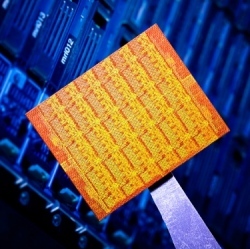
A completely new method of manufacturing the smallest structures in electronics could make their manufacture thousands of times quicker, allowing for cheaper semiconductors.
Instead of starting from a silicon wafer or other substrate, the idea is to grow gallium arsenide semiconductor structures from freely suspended nanoparticles of gold in a flowing gas. Semiconductor nanowires are key building blocks for the next generation of light-emitting diodes, solar cells, and batteries, according to Lund University researchers.
Behind the discovery is Lars Samuelson, Professor of Semiconductor Physics at Lund University, Sweden, and head of the University’s Nanometer Structure Consortium. He believes the technology will be ready for commercialization in two to four years. A prototype for solar cells is expected to be completed in two years.
“When I first suggested the idea of getting rid of the substrate, people around me said ‘you’re out of your mind, Lars; that would never work.’ When we tested the principle in one of our converted ovens at 400°C, the results were better than we could have dreamed of,” he says.
“The basic idea was to let nanoparticles of gold serve as a substrate from which the gallium arsenide semiconductors grow. This means that the accepted concepts really were turned upside down!”
Since then, the technology has been refined, patents have been obtained and further studies have been conducted. In the article in Nature, the researchers show how the growth can be controlled using temperature, time and the size of the gold nanoparticles.
Recently, they have also built a prototype machine with a specially built oven. Using a series of ovens, the researchers expect to be able to “bake” the nanowires, as the structures are called, and thereby develop multiple variants, such as p-n diodes. A further advantage of the technology is avoiding the cost of expensive semiconductor wafers.
